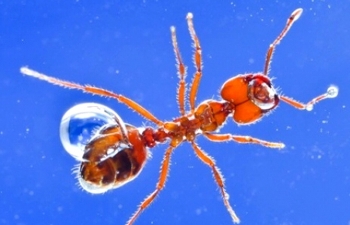A new research on ants indicates that even though they may march one by one they form a superstructure of thousands, creating a raft that puzzles the laws of physics. Ants contain exoskeletons that repel water.
They can walk or float on water mainly due to the buoyancy of the air bubbles, which get trapped along their bodies and also due to the water’s own surface tension. Surrounding the body and antennae is a thin layer of air. Nevertheless, when thousands of ants stand one on the other, their multiplied weight should make them go down. However this is not the case. Biologists have noted that fire ant colonies float on rivers and flood plains in South America.
 Fire ant
Fire ant
A group of engineers had decided to study the ant flotation from a physics angle. They found that ants float as a group mainly because they were able to use the power of air bubbles, which are close. The ants clasp each other’s front legs or mandibles using a force that is 400 times their body weight and trap small air pockets between them that act just like a group floatation device.
According to Nathan Mlot, who is a graduate student at Atlanta’s Georgia Institute of Technology and also one the authors of the study, the ants are knit tightly together, small air pockets are created between the ants and the water that prevent the water from penetrating through.
The ants’ bottom layer rests on top of the surface of water and other ants stack above them. When these ants get submerged, the air pockets would push them to the surface rapidly and permit them to breathe. The ants work in unison and form a tighter weave to avoid drowning.
In order to understand the concept behind the structure, the researchers captured a raft consisting of several thousands of ants and plunged them into liquid nitrogen, which was frozen immediately. After which they used an electron scanning microscope to view the structure of the ants level by level. They found that the raft was absolutely waterproof and kept afloat due to its ability to repel water.
Mlot also revealed that ants drown if soap is added to the water, as this addition significantly decreases the water’s surface tension and the raft of ants sink. These ants would have survived for weeks on the rafts without the soap addition. The researchers then decided to test the behavioral dynamics within the raft by picking the ants one by one from the top, but found to their surprise that a new one would climb from the bottom to maintain the raft thickness. The study may be applied in a variety of fields, including the development of robots.
The research study was published in the Proceedings of the National Academy of Science Journal
Source: http://www.gatech.edu/